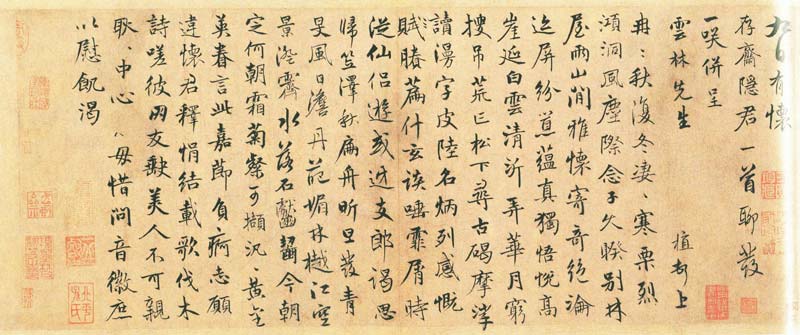Chen Zhi (1293-1362), whose courtesy name was Shufang and whose nickname was Shen Dusou, was born in Pingjiang Road (Suzhou). He "studied engineering and literature, understood hundreds of schools of classics and history, and was also good at painting landscapes, secluded bamboo and strange trees, each showing its unique style." It is said that Zheng Yuanyou's "Epitaph of Shendu Chenjun" and the first collection of "Selected Poems of the Yuan Dynasty" were found in Volume 12 of "Collection of Overseas Chinese in Wu".

"Huaicunzhai Poems", Chen Zhi, paper, running script, length 23.3 cm, width 56.4 cm, collected by the Palace Museum, Beijing
This is an ancient five-character poem written by Chen Zhi to "Cunzhai Yinjun", using poetry as a substitute for Cambodia. "Cunzhai" is Shen You, and Shen You signed himself "Cuncunzhai". Chen Ji's "Yibaizhai Manuscript" has an article "Cuncunzhai Ji", which says: "Shen Junzhong said (Shen Youzi Zhongshuo) lived in seclusion in Wu Hui cultivated and studied in Lize, and lived in the original residence of Chen Gong, so they all named his house Cun Cun Zhai." This poem also contains the sentence "Thinking of returning to Li Zeqiu", which is consistent with the above statement. In addition, Chen Zhi is often mentioned in the surviving calligraphy of Shen You. Among them, the "Poetry Calligraphy Post", that is, the "Poetry Notes with Uncle Fang", is for Chen Zhi, which shows that the two had a close relationship. "Yunlin", that is, Ni Zan, was also in Wuzhong at that time.
This post is basically based on the calligraphy of Zhao Mengfu. Some of the characters have a structure slightly similar to that of Zhao's calligraphy, and the pen is also used properly. However, many of the characters are written casually and not very carefully, probably for the purpose of relaxing and natural. , but due to lack of skill, many characters are poorly formed and the center of gravity appears unstable. On the back of the post are the words "Shen Du Zhai" and "One Hill, One Valley" in red and white inscriptions on each side. It can be seen from the seal on the post that it was collected by Xiang Zijing, Sun Chengze, An Yizhou, etc. in the Ming and Qing Dynasties. After 1949, it was collected by the Palace Museum in Beijing.








